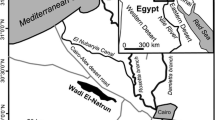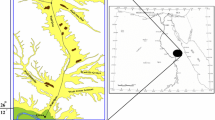Abstract
The evaluation of the groundwater occurrences needs integration of more than one technique to give an accurate estimation of the groundwater potential. Since, the West Nile Delta suffered from the deterioration in groundwater due to intensive of exploitation which resulted in both groundwater depletion and salinity increase. So, the integrated geophysical, hydrological and isotopic investigations were carried out in Wadi El Farigh, western Nile delta to monitor and assessment of the changes in the groundwater level, quality, aquifer renewability and mixing between existing aquifers. Geophysical results reveal that there are two aquifer separated by basaltic sheet. The first one is represented by the Miocene aquifer (El-Moghra) and the second one is the Oligocene aquifer which has lower resistivities than the upper one and this is mainly due to increase of clay content and the water salinity. Hydrological results reveal that the saturated thickness of Miocene aquifer decreased during (2003–2015) period and this depletion was approximately ranged between 1.3 and 1.7 m/year. Total dissolved solids (TDS) content of groundwater samples varies from 234 to 2458 mg/L implying significant deterioration and salinization problems. Application of Drinking Water Quality Index (DWQI) reveals that water samples are ranked between excellent category (~33%) to poor category (~67%) which is almost always threatened or impaired. The δ18O–δ2H relationship is suggesting that two distinct sample groups were classified according to their isotopic compositions. These two groups are nonrenewable and have isotopic signals varied completely according to the time of recharge. The relation between δ18O‰ and Cl concentration in (epm) suggested that both of two groups are exposed to dissolution as a result of an over-pum** process or mixing with more depleted strata (Oligocene aquifer) through the faults as in group 2 that exhibits more saline water and more isotopic depletion. Results indicate that most of the wells are operated at relatively high pum** rates accompanied with low efficiency and specific capacities besides decline of well yields and water deterioration.
Access this chapter
Tax calculation will be finalised at checkout
Purchases are for personal use only
Similar content being viewed by others
References
Shata AA (1962) Geology, hydrology and groundwater hydrology of Wadi El-Natrun and adjacent areas, Internal report, PT. 1, Cairo, U.A.R., Desert Institute
Pavlov M (1962) Hydrogeology, in preliminary report on the geology, hydrogeology and groundwater hydrology of Wadi El-Natrun and the adjacent areas, Part 2, Cairo, U.A.R., Desert Institute, The General Development Organization, p 63
El-Fayoumy IF (1964) Geology of groundwater supplies in Wadi El-Natrun area. MSc thesis, Faculty of Science, Cairo University, p 109
Sanad S (1973) Geology of the area between Wadi El-Natrun and the Moghra depression. PhD thesis, Faculty of Science, Assiut University, Assiut, Egypt, p 184
El-Shazly EM, Abdel Hady M, El-Ghawaby H, El-Kassas K, Khawasik SM, El-Shazly MM, Sanad S (1975) Geologic interpretation of Landsat satellite images for West Nile Delta area. Remote Sensing Center, Academy of Scientific Research and Technology, Cairo, Egypt, p 38
Attia SH (1975) Pedology and soil genesis of the Quaternary deposits in the region West of the Nile Delta, North and East of Wadi El-Natrun. PhD thesis, Faculty of Science, Ain Shams University, Cairo, Egypt, p 258
El-Ghazawi MM (1982) Geological studies of the Quaternary-Neogene aquifers in the area northwest Nile Delta. MSc thesis, Faculty of Science, Al-Azhar University, Cario, Egypt, p 170
Abdel Baki AMA (1983) Hydrogeological and hydro-geochemical studies in the area west of Rosetta branch and South El Nasr canal. PhD thesis, Faculty of Science, Ain Shams University, p 156
Shata AA (1959) Geological problems related to the groundwater supply of some desert areas of Egypt. Internal report, Desert Institute, Cairo, Egypt
Shata AA, El-Fayoumy IF (1967) Geomorphological and morphopedological aspects of the region west of the Nile Delta with special reference of Wadi El-Natrun area. Bull Inst Desert d’Egypte T XVIII(1):1–28
Said R (1962) The geology of Egypt. Elsevier Publishing Co., Amsterdam, New York, p 380
Shata AA (1955) An introductory note on the geology of the northern portion of the Western Desert of Egypt. Bull Inst Desert d’Egypte T 5(3):96–106
Abd El Rahman AA (1996) Geophysial study on the groundwater conditions in the area southwest of the Nile Delta between Abu Raoash and El Khatatba road. MSc thesis, Faculty of Science, Ain Shams University, p 116
Omara SM, Sanad S (1975) Rock stratigraphy and structural features of the Rea between Wadi El Natron and Moghra Depression. Western Desert, Egypt, pp 1–54
El Ghazawi MM, Atwa SM (1994) Contributions of some structural elements to the groundwater conditions in the southwestern portion of the Nile Delta. Geological Society of Egypt, Cairo, Egypt, 38(2), p 49
Sobeih MM, El-Arabi NE, Esam E-D, Helal BSA (2017) Management of water resources to control groundwater levels in the southern area of the western Nile delta, Egypt. Water Sci 31:137–150
Nofal ER, Fekry AM, Ahmed MH, El-Kharakany MM (2018) Groundwater; extraction versus recharge; vulnerability assessment. Water Sci 32:287–300
Mohamed Ibrahem SM (2020) Groundwater hydrology and characteristics of the tertiary aquifers, Northwest Cairo, Egypt. NRIAG J Astron Geophy 9(1):420–432
Ibrahim SMM (2005) Groundwater resources management in Wadi El-Farigh and its vicinities for sustainable agricultural development. PhD thesis, Faculty of Engineer, Ain Shams University, Cairo, p 152
Gad M, El Hattab M, Galal Sh (2016) Assessment of the Miocene aquifer in Wadi El-Farigh area by using GIS techniques. NRIAG J Astron Geophys 5(2016):463–473
Youssef AMA, Ibrahim SMM, Hussien RA (2017) Monitoring and assessment of groundwater in the area of Km80, Cairo-Alexandria highway using geophysical, hydrological and isotopic techniques—case study. Egypt J Geol 61(2017):41–67
Van Der Velpen BPA (1988) RESIST, version 1.0, a package for the processing of the resistivity sounding data. MSc Research Project, ITC, Deft, the Netherlands
Interpex Limited (1996) RESIX- PLUS, Reistivity data interpretation software, v. 2.39. Golden, Colorado, USA
WHO (2011) Guidelines for drinking water quality, 4th edn. World Health Organization Geneva, Recommendations, pp 1–4
Konikow L, Reilly T (1999) Seawater intrusion in the United States. Seawater intrusion in coastal Aquifers—concepts, methods and practices. Springer, pp 463–506
Rhoades JD, Kandiah A, Mashali A (1992) The use of saline waters for crop production. FAO
Piper AM (1944) A graphic procedure in the geochemical interpretation of water analysis. In: American geophysical union transactions, vol 25, pp 914–923
Appelo C, Williemsen A (1987) Geochemical calculations and observations on salt water intrusion, I: a combined geochemical mixing cell model. J Hydrol 94:313–330
McLean W, Jankowski J (2000) Groundwater quality and sustainability in an alluvial aquifer, Australia. In: Sililo A (ed) XXX IAH congress on groundwater: past achievements and future challenges. A.A., Balkema, Rotterdam
Custodio E, Bruggeman GH (1987) Groundwater problem in coastal areas. UNESCO publication Bielt Frers, Fleurs, Belguim
Garrels RM, Mackenzie FT (1971) Gregor’s denudation of the continents. Nature 231:382–383
Stumm W, Morgan JJ (1981) Aqautic chemistry. Wiley Interscience, New York
EHCW (2007) Egyptian higher committee for water and Egyptian standard for drinking water and domestic uses (in Arabic)
CCME (Canadian Council of Ministers of the Environment) (2001) Canadian water quality guidelines for the protection of aquatic life: CCME Water Quality Index 1.0, Technical Report. In: Canadian environment quality guidelines, 1999, Canadian Council of Ministers of the environment, Winnipeg
Hagagg KH (2009) Water resources evaluation and environmental assessment of the southwest area of the Nile Delta. MSc thesis, Faculty of Science, Cairo University
Author information
Authors and Affiliations
Editor information
Editors and Affiliations
Rights and permissions
Copyright information
© 2021 Springer Nature Switzerland AG
About this chapter
Cite this chapter
Youssef, A.M.A., Ibrahem, S.M.M., Hussien, R.A. (2021). Groundwater Ocurrences in West Nile Delta, Egypt. In: Negm, A., Elkhouly, A. (eds) Groundwater in Egypt’s Deserts. Springer Water. Springer, Cham. https://doi.org/10.1007/978-3-030-77622-0_3
Download citation
DOI: https://doi.org/10.1007/978-3-030-77622-0_3
Published:
Publisher Name: Springer, Cham
Print ISBN: 978-3-030-77621-3
Online ISBN: 978-3-030-77622-0
eBook Packages: Earth and Environmental ScienceEarth and Environmental Science (R0)




